Country Report: Spain
Spain's recession-battered pharma sector adapts to a changing market environment and repositions itself for a return to healthy growth through expanding opportunities abroad.
This sponsored supplement was produced by PharmaBoardroom.
Project Director: Cameron Rochette
Project Coordinator: Alina Manac
Contributors: Gabriela Córdova
Project Publishers: Diana Viola, Julie Avena
To read exclusive interviews, visit www.pharmaboardroom.com
SPAIN: Back in the Game?
Beyond the headlines that heralded the start of the Eurozone crisis that rocked the Spanish economy in 2009, and the austerity measures that followed, the Spanish pharma community has remained pragmatic. "Despite the crisis, Spain is still the fifth biggest European market, and the general conditions to invest are favorable to the pharmaceutical industry," says Humberto Arnés, director general of Farmaindustria, the country's association for research-based pharmaceutical companies.

Sa moto, Miquel Barcelo, 1981
For years, Spain's pharmaceutical industry had been growing at a rate that would eventually become unsustainable.
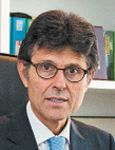
Humberto Arnés, Director General, Farmaindustria
The breaking point was reached in May 2010, when public pharmaceutical expenditure reached an all-time high. At that point, "Spain had a similar market size to the UK and Italy with a significantly smaller population. It would have been impossible to maintain that situation, and an adjustment of our market was absolutely necessary," remarks Arnés of Farmaindustria. "But after this adjustment that has already been made, further reductions to the pharmaceutical industry are not possible, without causing irreversible harm to patients and companies," he warns.
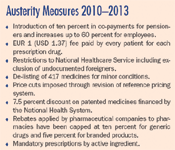
Austerity Measures 2010â2013
The Ministry of Health, under the administration of Prime Minister Mariano Rajoy, introduced a series of austerity measures in 2011 designed to curb costs following a series of similar measures made in 2006 and 2007. Most notably, these measures included a 7.5 percent price reduction for all patented medicines financed by Spain's National Health System (SNS), mandatory prescription by active ingredient, the de-listing of over 400 medications for minor conditions, and the introduction of a ten percent copayment for pensioners and increases of up to 60 percent for employees. As a result of these measures, pharmaceutical expenditure contracted 19 percent for the total market and a staggering 38 percent for the public market. As a country whose pharmaceutical expenditure is 80 percent public, the impact this had on the industry was immense.

Public pharmaceutical expenditure of GDP in 2013 (0.9%) is at a level similar to that of 1993
"National companies have been affected in that they do not have enough margins to keep up with the R&D investment needed to compete in international markets," continues Arnés. "Multinational companies have also been affected because they have more difficulties to replace their investments in R&D facilities that could become obsolete. As such, Farmaindustria is working with the Ministry of Health to build a stable framework for the long-term to avoid similar issues in the future by linking the growth rate of the pharmaceutical business to that of GDP."

Andreas Abt, General Manager, Roche Spain
On top of the various austerity measures implemented over the last few years, mounting debts by Spain's health authorities to the pharmaceutical industry had also become critical. Fortunately in 2011, Minister of Finance Cristóbal Montoro recognized this as a critical issue and established a plan to raise EUR 32 billion (USD 44.16 billion) to pay providers in a number of industries, including health.

Javier Anitua, General Manager, Mylan Spain
"This plan provided significant relief for the industry and was very important to demonstrate to our headquarters that the country is going through difficult times but is simultaneously serious about stepping up to its obligations," notes Andreas Abt, general manager of Roche Spain. "This was very helpful for us and had a big impact on our headquarters and in general for the image of the country."

Ãngel Luis RodrÃguez de la Cuerda, General Manager, AESEG
NONPROPRIETARY NONSENSE
The Spanish retail market dropped to EUR 9 billion (USD 11.36 billion) in 2012: sales in pharmacies dropped from 63.5 percent of the total market in 2009 to just 60.7 percent in 2012, according to IMS Health. This drop was due in part to laws implemented that force innovative companies to drop the prices of their brands once off-patent to the same prices as their generic competitors.

Generics timeline
"Generics in Spain only represent 18 percent of the total market in terms of value compared to 59 percent of products with patents and 23 percent of products with expired patents," says Ángel Luis Rodríguez, general manager of Spain's generic association AESEG. "In terms of units, generics represent 36 percent of market share, while patented brands represent 33 percent and brands with expired patents represent 30 percent. Again, this figure is far from the European average of generic market share of 55 percent." AESEG has called for a price differential between generics and off-patent brands as well as clearly defined times for patent expirations. The association also defends prescription by INN: "this is very important to AESEG because physicians and pharmacies study pharmaceutical products by INN, and most patients today tend to recognize pharmaceuticals by INN."

Luis Cruz, General Manager, Spain & Portugal, CSL Behring
"The average price of medicines has dropped by 25 percent in just three years thanks to short-term price cuts," says Javier Anitua, general manager of Mylan Spain. "This means that the average Spanish pharmacy has lost its net margin by 34 points over the last five years, with a net margin of less than seven percent. We cannot continue this trend." Anitua is pushing for new channels of income among Spain's pharmacies, which are struggling to make a profit due to price cuts. "This involves the preventive role that pharmacies can play through professional pharmaceutical services," continues Anitua.

Juan López-Belmonte, CEO of Laboratorios Rovi
"We need to establish an agreement of sustainability for pharmacies and provision of medicine with every industry stakeholder. Innovation needs to come, but to provide that innovation we need to activate the use of generics instead of creating more short-term price cuts."
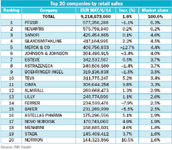
Top 20 companies by retail sales
THE SYSTEM IS DEAD, LONG LIVE THE SYSTEM!
"The old Spanish healthcare system has disappeared as it had proven to be unviable and unsustainable," says Luis Cruz, general manager of Spain and Portugal at CSL Behring. "Now we are in the process of switching to a new system that has yet to be formalized. We are trying to keep up with everything, but the process of defining this new system is not an easy one." CSL Behring, a leader in the plasma protein biotherapeutics industry worldwide, provides hospital-based treatments for a number of rare diseases, all of which are reimbursed by the authorities. "We know that in the future we will not be able to spend in healthcare as much as we have been spending until now," Cruz admits.
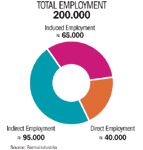
He nevertheless warns: "When new treatments for rare diseases are discovered preventing patients from dying and suffering, we have to generate 'new expenses.' The Ministry of Health must make new resources available for these patients who will not only survive, but who will often need these treatments for life."

Javier Ellena, President, Lilly Spain
"Spain was living in a bubble-like dream in many ways, above what the country and its economic capabilities could deliver," says Juan López-Belmonte, CEO of Laboratorios Rovi, a Spanish laboratory that has achieved significant growth during the economic downturn. "The recession of 2008 demonstrated across the globe that life is what you generate and what you can spend."
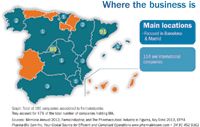
Where the business is
He notes that companies have adapted quickly to the new conditions: "Consequently, our adjustments have had a lasting effect on all companies. While the pharmaceutical business is fairly stable and regulated, the crisis has forced managers like myself to change our ways of thinking, to restructure our companies to allow for a faster decision-making process and to be more ambitious in R&D programs. Nevertheless, I am very optimistic regarding Rovi – we have prepared ourselves for the future, and the best is yet to come. We have increased our staff from 500 in 2007 to almost 1,000 in 2014."

Kristian Hart Hansen, General Manager, LEO Pharma Spain
The path to recovery may not be easy, but it certainly is not impossible for Spain either. "Thankfully, the worst days are behind us; looking at the future, Spain has incredible human talent, financial reforms in place and a very competitive labor market," remarks Javier Ellena, president and CEO Spain, Portugal and Greece of Lilly. "The transition from the past to the present has been difficult and painful, but we can be optimistic in that a new cycle is starting from a very healthy base as a consequence of all the measures implemented. Establishing parameters for handling potential innovation will be critical to ensure that the pharmaceutical sector will have a brilliant future in Spain."

Rogelio Ambrosi, Managing Director, Merck Spain
"Spain is a great country," concludes Rovi's López-Belmonte, "and we should keep investing in this country. The best of Spain is also yet to come. We went through difficult times, but the country has done its homework, has grounds for future growth, and will become a success story in the years to come."

Luigi Antoniazzi, General Manager Spain & Portugal, Baxter
A CHANGE OF PACE
The decentralized nature of Spain's health system presents its own unique challenges for health-related companies. Regulatory and reimbursement decisions are taken at the regional level, and many rules and regulations can vary from hospital to hospital within a region. While this concept is not new, the crisis has made each community even more stringent about its own laws, which creates a complex environment in which companies operate. As Luigi Antoniazzi, general manager Spain & Portugal of Baxter states, an advantage that this system provides, "is the opportunity to be closer to the patients, which is useful to fulfil the ultimate objective of providing a better service to the population of each region. On the flipside, needless to say, having to deal with 17 regional authorities is quite a challenge. Each one has a unique set of healthcare policies or interpretation of how healthcare services should be provided to citizens." As part of the adaptation to Spain's decentralized health system, many managers find themselves placing increased emphasis on the key stakeholders in each region, be it regional health authorities, hospital managers or others.
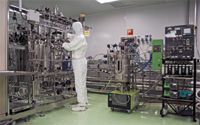
Merck’s biotech plant in Tres Cantos (Madrid)
"We were used to having one strategy for the whole country for each of our business areas," notes Kristian Hart Hansen, general manager of Leo Pharma Spain. "The first challenge is to understand the differences in the 17 regions and understand the needs of our different customers within each region in order to be able to adapt our plans and strategies to each stakeholder in each region." Hart Hansen notes that when the environment changes like it has in Spain, a whole revamp of strategy is required. "If you manage to do that — which is not easy here in Spain as well as in other countries — the opportunities will arise," he says. "The question is, do you dare to do it? One thing is certain: you need to move from a national to a regional perspective in terms of everything you do; there is no one-product strategy for Spain anymore. We are not there yet, but it has been an exciting part of the journey and it will continue."

Industry Spotlight: Medical Technology
"We have returned to a focus on science rather than just the relationship," remarks Rogelio Ambrosi, general manager of Merck Spain. "We have changed our organization from only having sales reps or key account managers to a mixed organization where our people actually promote the products. Companies today talk at great length about science, patient benefits and health economics, along with other departments like market access or government affairs. Merck has ensured that its products are available for all Spaniards by working directly with the responsible people in each region, from the minister and regional counselors to hospital managers. Spain is one country; where you live should not make a difference for accessing medications. There are stark differences in each community, and this is perhaps less to do with money as it is about how they organize themselves to make this happen. Merck Spain has changed its organization from only having sales reps or key account managers to a mixed organization where our people actually promote the products."
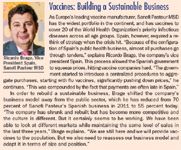
Vaccines: Building a Sustainable Business
Merck Spain has made significant efforts to increase its foothold in Spain. As the only multinational with three production centers in the country (chemicals, pharmaceuticals and biotech), Merck Spain recently announced plans to build a new facility at the affiliate's chemical site in Mollet del Vallès in 2015 and a EUR 10 million (USD 13.8 million) investment to consolidate its biotech site in Tres Cantos this year.

Maria Del Coriseo, CEO, ICEX
LOOKING ELSEWHERE
"In 2012, Spain's government undertook major economic reforms to help labor markets, contain the deficit and regain the confidence of international markets," says Maria del Coriseo, CEO of export and investment agency ICEX.
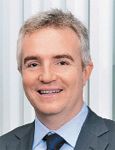
Ignasi Biosca, CEO, Reig Jofre
"This meant that our risk premium decreased, and our public and private financing costs for the whole country became more reasonable and affordable. Companies made great efforts too, continuing to invest in R&D and process innovation, obtaining their own brands, and generally maintaining flexibility and reliability while offering quality post-sales services. By the end of 2012, Spain had consolidated and also increased its exports by 38 percent, bucking the trend in surrounding countries. Today, the number of companies exporting is 50 percent higher than compared to three years ago. Companies with previous international experience became more focused in markets outside the European Union."
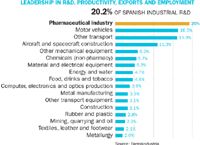
For Ignasi Biosca, CEO of local pharmaceutical group Reig Jofre, focusing on international markets was the key success factor for the company, which has managed to do everything from acquiring international companies like Bioglan in Sweden in 2009 to obtaining FDA approval to market its sterile penicillin-based antibiotics in the US in 2013. "The key point for Reig Jofre is to innovate new products that can be manufactured and marketed by ourselves in those markets where we have direct presence, or through our network of more than 180 partners, licensees and distributors in more than 52 countries worldwide," Biosca states.
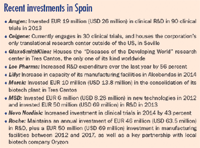
Recent investments in Spain
"Instead of growing through business units in every country, we have been growing through a network of partners to whom we offer every new product that Reig Jofre develops. In that sense, we are slightly more focused on the development side of R&D+i. We try to develop both real innovation, but also products that are not necessarily a new chemical entity but rather some developments or improved formulations or new indications for existing molecules that can be successfully marketed in each local market."

Maria Luisa Poncela, General Secretary of Science, Technology and Innovation
THE RESEARCHER'S DELIGHT
"The pharmaceutical sector is the leading industry in R&D in Spain," says Maria Luisa Poncela, general secretary of Science, Technology and Innovation for the Spanish Ministry of Economy, who believes that the industry needs to increase its investment in Spain even more. "Ten years ago, foreign pharmaceutical companies were investing in research in Spain but mainly in the later phases of drug development. At present there are big companies investing in Spain that entirely develop a drug here, from the preclinical phase until the last phase of clinical trials." Currently, the pharmaceutical industry invests roughly EUR 1 billion (USD 1.38 billion) annually in Spain; "this is a great path for Spanish knowledge and science, because many physicians of different hospitals are involved, as well as researchers of Spain's leading institutes."

Anabel Sanz, Head of Technology Transfer and Valorization, CNIO
"Spain is ranked tenth worldwide for production of science, measured in terms of publications and papers," notes Emilio Lora-Tamayo, president of the Spanish National Research Council (CSIC), the third biggest of its kind in Europe and ranked first in Europe in terms of output of papers and patents. "In the last ten years, we have tried to emphasize approaching translational focus of our biology and biomedicine activity, ranging from our very first steps in a biological molecule or chemical sources to the end of the clinical process to treat different diseases. This is particularly important in the fields of neurological, chronic and rare diseases." Spain currently invests 1.4 percent of its GDP in research; Lora-Tamayo wants to see this number increased to two percent. "The importance of this figure is that the majority of this investment effort is made by the public sector," comments Lora-Tamayo. "The private sector in Spain is far below the European average, and needs to make a much stronger effort."

Emilio Lora-Tamayo, President, CSIC
One of the most notable examples of Spain's research prowess in the life sciences is the Spanish National Cancer Research Center (CNIO). "Considering such a structure takes time to develop, CNIO is an impressive institution given that it is only ten years old," comments Anabel Sanz, head of technology transfer and valorization at CNIO. "In 2013 CNIO partnered with companies to develop novel drugs through applied programs. The two very first novel products entirely developed at CNIO through our drug discovery platform have been licensed to companies that can help us take these products forward into the clinical stages of drug development." CNIO is ranked as the number one research center in Spain in terms of scientific production in cancer, and number two for high impact on cancer publications worldwide. "We publish more than 200 papers per year and in particular we have been increasing the number of publications with high impact, considered to be highly influential in their fields, since 2010, up to a 22 percent increase in 2013," says Sanz.

Joan Guinovart, Director, IRB Barcelona
CATALAN COMPETITIVENESS
As a region, Catalonia is quite impressive in terms of its research capacity: Joan Guinovart, director of the Institute for Research in Biomedicine in Barcelona (IRB Barcelona), notes that the region on its own ranks third in Europe, behind the Netherlands and Sweden, for the number of grants provided by the European Research Council per million inhabitants. "IRB is a member of a network called the Research Centers of Catalonia (CERCA), which belongs to the Catalan Government," states Guinovart. "This is a body that brings together a new type of research center that does not fit the traditional rigid structures common to Spain over decades." Combined with a Catalan government-owned agency designed specifically for international recruitment, the region's system "has maintained the same policy of attracting and recruiting the best international talent through open calls for over 15 years and the impact has rapidly become evident."

Luis Serrano, Director, Centre for Genomic Regulation
"The Catalan government has really bet that innovation is the future for competitiveness; they have devoted large amounts of money to protect research," says Luis Serrano, Director of the Center for Genomic Regulation (CRG). The next step, according to Serrano, is to take this high-quality research to the next level. "Governments need to keep their investments in science and technology alive during such times to push the economy, and innovation is critical for this," he remarks. "Now Catalonia has globally competitive institutes in terms of research, but like the CRG they need to become competitive specifically in tech transfer and translational medicine. Publishing is great and our access to EU grants has been superb, but at some point we need to start returning value to the society that finances us."
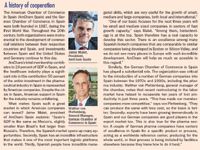
A history of cooperation
WITH GREAT RESEARCH SHOULD COME GREAT COMMERCE
Spain has the sixth largest number of registered biotechnology companies worldwide. "The high quality science that exists in Spain helps to create that environment, and certainly the good funding that existed in the past also contributed," says Carmen Castresana, director of the National Biotechnology Center (CNB). "In fact, for many years, Spain was a great place to create startups in general and as such there was higher international visibility for science and research. But funds have also been cut for biotech companies in recent years, just like the research institutes. There also used to be money in every university campus nationwide; science parks and incubators were being created for small enterprises. We are still waiting for recovery phase to begin."

Carmen Castresana, Director, CNB
"Spain has invested a great deal of capital in this area, and ranks fifth in Europe and seventh worldwide for scientific production," comments Regina Revilla, president of Spain's biotechnology association ASEBIO. "Many of the key opinion leaders in the health area in Spain today chair the governing boards of a number of leading research institutes in the country as well. Considering where Spain was in the beginning of the 1980s, when the country was being assisted by the World Bank to develop technologies, we have come a long way. It may have taken a long time, but Spain is finally developing incredibly groundbreaking products and with stronger intellectual property protection." The fruits of some biotech companies in Spain are finally beginning to blossom as well; local company PharmaMar's groundbreaking marine drug Yondelis is on the brink of approval by the FDA, while Roche established a partnership earlier this year with Oryzon to co-research, develop and commercialize inhibitors of Lysine Specific Demethylase-1, an epigenetic modulator that regulates gene expression.
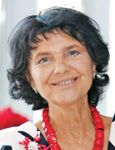
Regina Revilla, president, ASEBIO
Spanish companies and research institutes are also placing a large emphasis on personalized medicine. "Spain's strength in the development of biomarkers is outstanding for the creation of an interesting and innovative healthcare system, particularly in the areas of hematology and oncology," comments Revilla. "Combined with Spain's program involving the public purchase of new technologies, the opportunities to improve clinical outcomes and reduce costs are endless. Considering there is really only one buyer of such technology in Spain, the public, we can really develop these purchases in-house for innovative technology, covered with government funds."

Predicting life
WHERE THE BUSINESS IS
While Spain has never built a global pharmaceutical giant like their close neighbours in France, UK, Germany or Switzerland, the ecosystem in Spain has certainly allowed for strong growth despite the country's financial crisis. With over 3,000 clinical trials being conducted in 800 hospitals across the country combined with its low-cost appeal, Spain is still a very attractive place for companies to invest in for research and production.

Almirall: A Spanish model for innovation?
"Spain's efforts in R&D, manufacturing, marketing and intellectual property have continued as normal in the last few years," says Antoni Esteve, director of Esteve. "The real problem is the way which these assets are managed and prioritized. Much of the country's issues depend on public services that establish their criteria regarding how many resources they deserve compared to others, and the government needs to confront this. Essentially, this is not a crisis of the sector, but an economic crisis that impacts the health sector. Accordingly, as the pharmaceutical industry we are obliged to rethink how our products may play a role in this new environment."
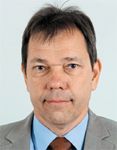
Joachim Teubner, General Manager, Medinsa
For those multinationals that have not invested in manufacturing or R&D products, the market still offers plenty of ways to still be a potent player in the game. "We commit to R&D by using Spanish resources to invest in local and European projects," says Alberto Martínez, general manager Spain & Portugal of Mundipharma. "We also have partnerships with local product suppliers based in Spain, such as Alcaliber (morphine and oxycodone API suppliers), and Inke (formoterol exclusive worldwide supplier). The growth and development of local pharmaceutical companies like these are also dependent on the development of companies like Mundipharma Spain." Mid-sized companies like Mundipharma cannot always afford to establish R&D or manufacturing capabilities in Spain. Nevertheless, Martínez is optimistic about his affiliate's efforts to contribute what it can. "We hope the authorities will recognize our firm commitment with innovation, with a growing contribution to the Spanish GDP and towards a sustainable healthcare system."

Antoni Esteve, Director, Esteve
The actual production of pharmaceutical products and forms offers a significant portion of business as well, as a remnant of the Francoist-era push for the industrialization of Spain, particularly in the chemical area. "Spain has historically had a huge infrastructure in pharmaceuticals and chemicals, as well as APIs and finished dosage forms," says local contract manufacturer Medinsa's CEO Joachim Teubner. "The country is building upon this as a competitive advantage. Today, price is one of the most important criteria when deciding on contract manufacturing or in-house manufacturing. Given that there are usually benchmarks, you have to be competitive in your pricing. The government has made some adjustments during and after the crisis, especially for labor laws, which will enhance Spain's positioning for foreign companies to use this country as a hub for manufacturing their products. This change will strengthen Spain's direction and I am optimistic that the country's current infrastructure will grow."

Alberto Martinez, General Manager Spain & Portugal, Mundipharma
Newcomers to this area also have an enormous slice of pie to take. One such example is Aplicaps, a local manufacturer of soft-gelatin capsules, founded in 2008. "The Spanish market is big but everyone is playing in it, both local and multinational companies," comments José Luis Martín Guinea, CEO of Aplicaps. He sees an immense opportunity available in the Spanish market for this niche. "Many companies in Spain are essentially commercial and their problems are mainly located in R&D and the manufacturing of their products," he says. "Once we reach our customers' trust it is very likely that they come to us for other projects. 30 percent of our sales are met in other product ranges, and some of our best clients ask us to solve other issues for which we have the capacity to undertake. We then sign deals with other companies specialized in the area of expertise required and they eventually collaborate under our responsibility and supervision to realize the product ordered."

José Luis MartÃn Guinea, CEO, Aplicaps
TOO MUCH JAMÓN
"5.3 million Spaniards suffer from diabetes," says Erik Lommerde, vice president Spain & Portugal of Novo Nordisk. "This is much more than the average ten percent, so it is more severe in Spain than many other countries, particularly in Europe. This is linked to Spain having the highest obesity in Europe, a key driver of Type 2 diabetes. This will not fade either; obesity rates will only worsen. More importantly, only half of the people with diabetes are diagnosed. The challenge for those being diagnosed then is to receive the right treatment."
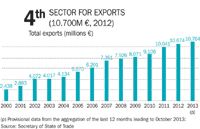
In 2013, Spain finally balanced the trade of pharmaceutical products at EUR 10.7 billion (USD 14.76 billion) through companies’ increased activity in third-tier markets and general internationalization (Source: Farmaindustria)
In terms of diseases, diabetes represents the highest cost for the Spanish government (eight percent of the total health budget) and is certainly a priority. "The problem is that they do not see the whole picture, which includes aspects like hospital costs or late complications due to a poor control of the disease," continues Lommerde. "If they see the whole picture, then diabetes medication will cost less than ten percent. But because it is politically very interesting to talk about the cost of drugs, short term objectives, and not interesting to talk about late complications that you might prevent ten years from now by providing education, you will see a lot of focus in Spain and Europe on medication."

Strength in Numbers
In order to change this, companies like Novo Nordisk have decided to work much more with Spain's autonomous communities to teach and train individuals to live healthier lifestyles. "The challenge is that there is a lack of trust in the pharmaceutical industry by people, despite our intention to do well," Lommerde concludes. "Many in Spain do not understand that if we do nothing, we will make much more money in the future because the number of diabetes cases will skyrocket. I hope the government sees that Novo Nordisk takes Spain very seriously. This should allow us to work together to tackle the burden of diabetes and to ensure we have innovation in the market. We can do this because the quality of clinical research in Spain is outstanding and there are enough patients. Because Spain is good in research, Novo Nordisk quite often chooses this country for early phases of research."

Erik Lommerde, Vice President Spain & Portugal, Novo Nordisk
